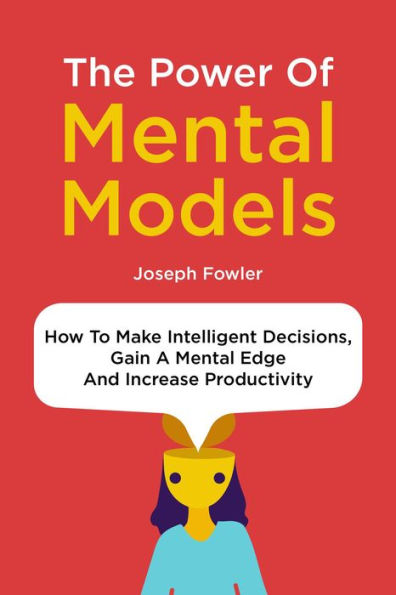Have you ever thought to question your thinking?
Did you know you use mental models every day?
Or have you ever felt in a mental rut where nothing is new and exciting to think about?
If you are curious about any of these questions, this guide will give you the answers you have been searching for.
So many people have no idea what a mental model is - or that they control our lives.
Mental models are the mind's framework to help us make sense of the world, solve problems, and make informed decisions.
They are built with your education, past experiences, and habits of thought you create over time.
But did you know your mental models can go wrong?
And even be harmful to your life?
Harmful models come from biases or ill-formed beliefs, which can cause you to have low self-esteem, depression, and poor relationships.
Understanding how mental models work is the first step towards using models to make you function more efficiently, make better, more logic-based decisions, and use your mental energy more wisely.
In his influential 2011 book Thinking: Fast and Slow, Daniel Kahneman explains the two systems of thinking the brain has and why it uses mental models.
He reveals that while part of our thinking is slow, thoughtful, and requires effort, the other part of our brain wants to conserve energy, using mental models to build shortcuts and patterns to automate our thoughts.
In this guide, you'll learn:
- The best and most effective way to train your mind, just like you train your body, to reach your greatest potential and find your power!
- Why your intuition may be seriously hindering or even hurting you
- The most-used models and how to reverse them to find mental flexibility and opportunity
- How you're unconsciously limiting yourself and narrowing your mind
- The key to getting out of your mental rut, before it's too late!
- How to rid yourself of your "default" ways of thinking to improve your relationships, and love yourself
- How to maximize life's benefits by changing your thinking!
- Why the most successful and happiest people are so good at "thinking out of the box" and how you can too!
Get a step ahead of everyone else by understanding your models, beliefs, and biases, so that you become aware of when they are affecting your choices and judgments.
With this guide, you will build your mental toolbox to more efficiently and effectively make decisions, solve problems, and realize your life's greatest potential.
Reclaim control of your mind from your mental models to achieve your best self by clicking "Add to Cart" right now!
Have you ever thought to question your thinking?
Did you know you use mental models every day?
Or have you ever felt in a mental rut where nothing is new and exciting to think about?
If you are curious about any of these questions, this guide will give you the answers you have been searching for.
So many people have no idea what a mental model is - or that they control our lives.
Mental models are the mind's framework to help us make sense of the world, solve problems, and make informed decisions.
They are built with your education, past experiences, and habits of thought you create over time.
But did you know your mental models can go wrong?
And even be harmful to your life?
Harmful models come from biases or ill-formed beliefs, which can cause you to have low self-esteem, depression, and poor relationships.
Understanding how mental models work is the first step towards using models to make you function more efficiently, make better, more logic-based decisions, and use your mental energy more wisely.
In his influential 2011 book Thinking: Fast and Slow, Daniel Kahneman explains the two systems of thinking the brain has and why it uses mental models.
He reveals that while part of our thinking is slow, thoughtful, and requires effort, the other part of our brain wants to conserve energy, using mental models to build shortcuts and patterns to automate our thoughts.
In this guide, you'll learn:
- The best and most effective way to train your mind, just like you train your body, to reach your greatest potential and find your power!
- Why your intuition may be seriously hindering or even hurting you
- The most-used models and how to reverse them to find mental flexibility and opportunity
- How you're unconsciously limiting yourself and narrowing your mind
- The key to getting out of your mental rut, before it's too late!
- How to rid yourself of your "default" ways of thinking to improve your relationships, and love yourself
- How to maximize life's benefits by changing your thinking!
- Why the most successful and happiest people are so good at "thinking out of the box" and how you can too!
Get a step ahead of everyone else by understanding your models, beliefs, and biases, so that you become aware of when they are affecting your choices and judgments.
With this guide, you will build your mental toolbox to more efficiently and effectively make decisions, solve problems, and realize your life's greatest potential.
Reclaim control of your mind from your mental models to achieve your best self by clicking "Add to Cart" right now!

The Power Of Mental Models: How To Make Intelligent Decisions, Gain A Mental Edge And Increase Productivity

The Power Of Mental Models: How To Make Intelligent Decisions, Gain A Mental Edge And Increase Productivity

Product Details
| BN ID: | 2940164540449 |
|---|---|
| Publisher: | M & M Limitless Online Inc. |
| Publication date: | 07/28/2020 |
| Sold by: | Draft2Digital |
| Format: | eBook |
| Sales rank: | 464,276 |
| File size: | 300 KB |
